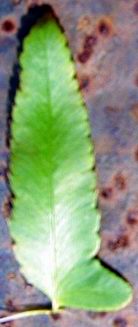|
Return to Hiker's Notebook Home Page
Common Name: Christmas fern, Canker Brake, Dagger Fern, Evergreen Wood Fern
Scientific Name: Polystichum acrostichoides - The generic
name is from the Greek polys meaning much or many and
stix meaning row in reference to the regular rows of sori (spore
cases) on the underside of the fertile fronds. The species name is from the
Greek akros meaning at the point, end or top and the same
stix as the genus, here emphasizing that the rows of sori
are at the top end of the frond.
The Christmas fern derives its name from the fact that it was formerly used as a Christmas decoration since it is evergreen and a very common and widespread fern in wooded areas near streams. As a mnemonic for the naturalist, the leaf (pinna) of the Christmas fern resembles a Christmas stocking (or Santa's boot)
The fronds of the Christmas fern are erect through the summer, declining in the fall to become recumbent and dying after the first hard frost. They stay in this position, holding the leaf litter and duff in place and are therefore effective in erosion control. The Christmas fern is dimorphic, having two different kinds of fronds on the same plant. The smaller fronds are sterile. The larger fronds are sterile on the lower two thirds and fertile only on the upper third; due to the constriction of the sori, the upper, fertile fronds appear stunted. The Christmas fern was used by several Indian tribes for medicinal purposes. The root was made into a tea to treat chills and fever and to induce vomiting to treat stomach aches. A poultice was made from the roots to treat rheumatism. |

